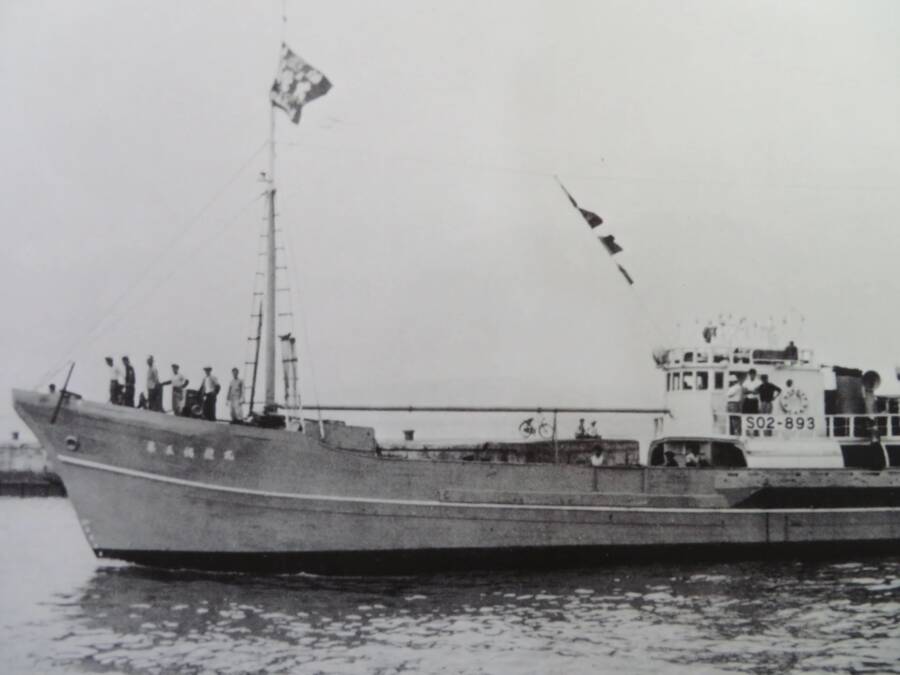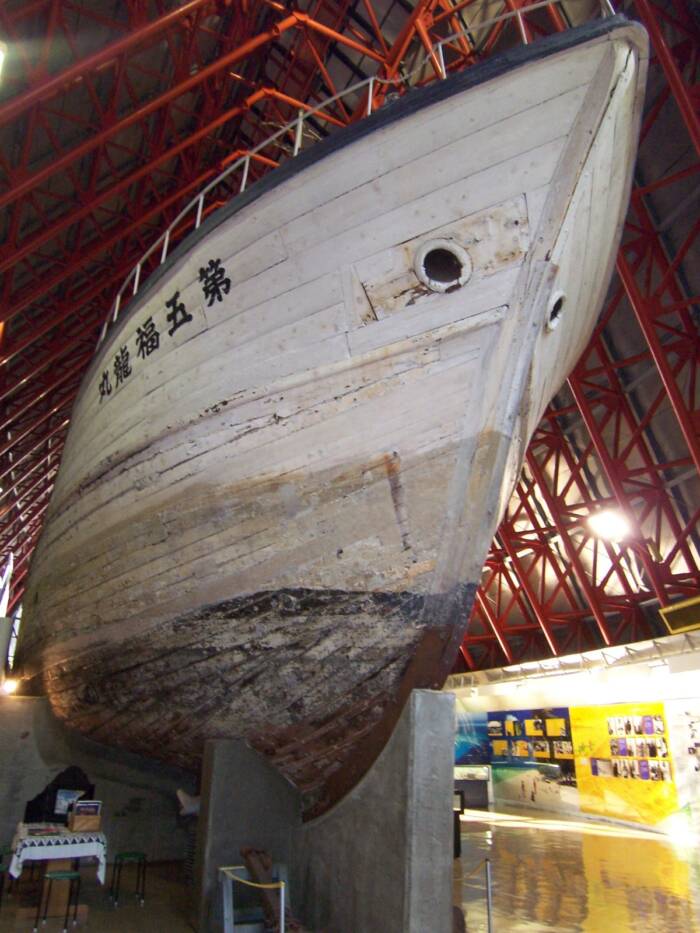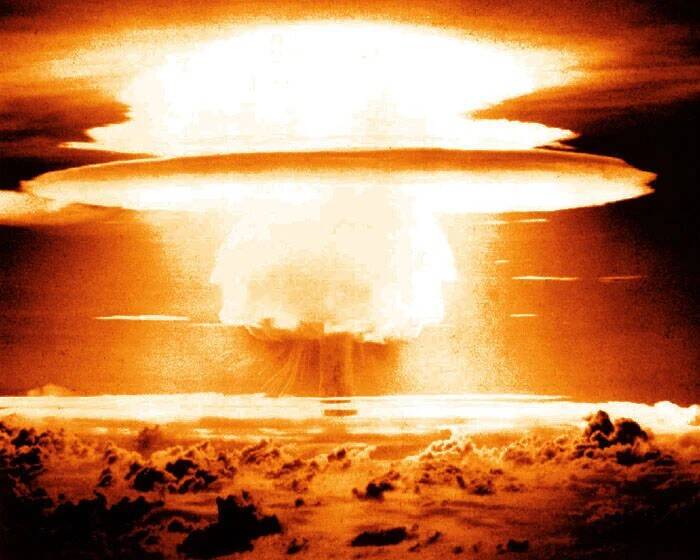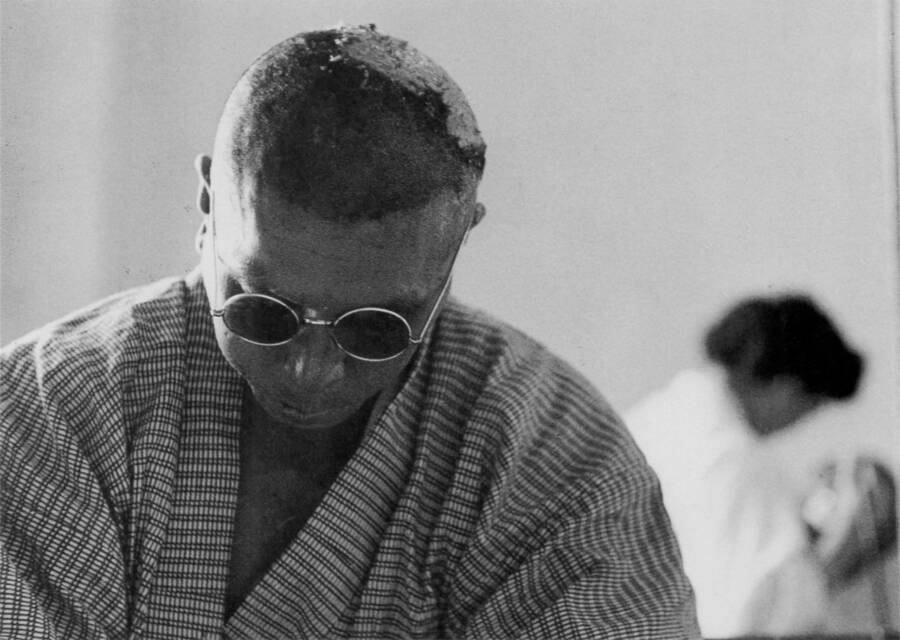On March 1, 1954, 23 crew members on the Lucky Dragon were poisoned by radiation when the fallout from the Castle Bravo nuclear test rained down on their ship, which was floating about 80 miles from the detonation site at Bikini Atoll.

Nuclear Age Peace FoundationThe Lucky Dragon ship, or Daigo Fukuryū Maru.
From the start of its voyage in 1954, the Lucky Dragon ship had a hard time. After launching in January, the crew of the small Japanese fishing trawler had engine trouble and few catches, and they even lost half of their lines to coral reefs. Then, on March 1, things got much worse. The Lucky Dragon was fishing for tuna near the Marshall Islands when the ship was caught in the powerful fallout of the Castle Bravo nuclear test.
Though the ship had missed a warning about a possible nuclear explosion on March 1, they were 86 miles away from the test site and thus outside the officially declared danger zone. However, the Castle Bravo test was twice as powerful as expected, and it detonated with a thunderous explosion 1,000 times more powerful than the bomb dropped on Hiroshima.
The crew of the Lucky Dragon returned to Japan in deteriorating health, and their story spread fear around the world about American nuclear tests. The boat’s radioman, Kuboyama Aikichi, died several months later, and many of the other men onboard died from cancer and cirrhosis of the liver in the years to come.
The story of the Lucky Dragon ship also made a lasting impact on the world in an unexpected way: It inspired screenwriter Ishirō Honda as he wrote Godzilla.
The Bad Luck Of The Lucky Dragon Ship

resource70/Wikimedia CommonsThe Lucky Dragon is now on display in Tokyo.
The Lucky Dragon ship, or Daigo Fukuryū Maru, had bad luck from the beginning.
After launching on Jan. 22, 1954, the 23-man crew of the Japanese fishing boat encountered a myriad of problems. The ship’s original captain fell ill, the ship had constant engine trouble, and the crew lost half of their lines to coral. What’s more, after over a month at sea, the fishermen had hardly caught any tuna.
Five weeks into the voyage, the crew decided to fish in the waters east of the Marshall Islands. It was a last resort. The men knew that the United States sometimes conducted atomic tests in the area, though they were reportedly more worried about offending the Americans than for their health.
That said, the ship had also missed a warning from the Japanese Maritime Safety Board about the possibility of an atomic test in the area on March 1, according to David Halberstam’s book The Fifties.
Unbeknownst to the crew of the Lucky Dragon — and the world — America was quietly gearing up for one of its biggest nuclear tests yet. The military was preparing to detonate a hydrogen bomb that would become known as the most powerful nuclear device ever detonated by America.
The Powerful Explosion From The Castle Bravo Test
The Castle Bravo test took place at 6:45 a.m. on March 1, 1954. The scientists involved believed that the hydrogen bomb would have a yield of seven megatons. Instead, it was more than twice as powerful. With a yield of 15 megatons, the hydrogen bomb of the Castle Bravo test was 1,000 times more powerful than the atomic bomb dropped on Hiroshima.

Public DomainThe Castle Bravo test was more than twice as powerful as scientists had predicted.
On the Lucky Dragon ship, one of the crew members happened to be on the deck at the time of the detonation. To his surprise, he saw that the sky was lightening — and then it began to turn a flaming orange color. The man woke his shipmates, and one of them cried, “It’s a pika-don!” This was a new word, born from the horror of Hiroshima, that meant “thunder and flash.”
“Suddenly the boat has been surrounded by a bright light. Such an early dawn is impossible. Makes feel something very dangerous,” Yoshio Masaki, the ship’s fishing master, recorded in his log, according to a 2018 report in the Bulletin of the Atomic Scientists. “[N]ine minutes later a roaring sound arrives like overlapping avalanches. Bang, bang, bang, bang — an awful sound like the Marshall Islands are sinking as angry waves into the sea.”
The air cracked, the ocean convulsed, and the crew of the Lucky Dragon ship saw a huge mushroom cloud bloom into the morning sky.
Though the Lucky Dragon was around 86 miles away from the test, and thus outside of the official warning zone, the fallout from Castle Bravo spread much further than expected. Two hours after the explosion, “white sand” started falling on the crew, and the men soon became ill. Their bodies ached, they lost their appetites, their skin darkened, they became feverish, and they developed sores on their fingers and necks, which had been exposed to the radioactive ash.
By the time the Lucky Dragon ship got back to Japan on March 14, the crew was even sicker. Their hair was falling out. They had headaches, bleeding gums, and burns on their skin. The fishermen were quickly taken to the hospital, where, as the press reported, they were diagnosed with “A-bomb disease.”
“From this day on,” the ship’s radioman, Kuboyama Aikichi, wrote in his journal, “unhappiness in our family began.”
The Fate Of The Lucky Dragon Ship’s Crew — And Their Impact On The World

Public DomainMasuda Sanjirō, a member of the Lucky Dragon crew, in the hospital.
In Japan, the story of the Lucky Dragon ship was met with outrage and fear. The men on the vessel had been far away from the blast and yet had been sickened by what the Japanese called shi no hai, or “death ash.” Soon, a new word came to describe what the fishermen had experienced: fallout.
What’s more, the Lucky Dragon had delivered more than nuclear-contaminated men to Japanese shores. Tests on the ship’s tuna proved that the fish was contaminated as well. The U.S. Atomic Energy Commission (AEC) attempted to downplay the risk, but food companies around the world refused to buy Japanese fish following the incident.
Indeed, as outrage toward the U.S. rose, some American policymakers refused to believe that the Lucky Dragon crew was really sick at all. Lewis Strauss, the head of the AEC, told President Dwight D. Eisenhower that the fishermen were part of a Soviet plot to embarrass the U.S. James Hagerty, the president’s press secretary, privately agreed.
“Lewis Strauss and others suspect this boat was a Red Spy outfit,” Hagerty wrote in his diary. “Suspect this is part of a Russian espionage system, but we don’t want to say so publicly… Interesting story and hope it will come out some day.”
In Japan, however, the fate of the Lucky Dragon ship’s crew was all too real. Virtually the entire nation held vigil as Aikichi, the ship’s 40-year-old radioman, began to die from painful radiation sickness.
“My body feels like it is being burned with electricity,” he cried. “Under my body there must be a high-tension wire.”
When Aikichi died on Sept. 23, however, American authorities in Japan claimed he’d died of hepatitis. TIME also reported at the time, “Some doctors, citing Aikichi’s bad liver, apparently questioned whether radiation had been the cause of death,” though the magazine acknowledged his official cause of death was “radiation disease.”

Public DomainA doctor uses a Geiger counter on one of the fishermen from the Lucky Dragon two days after the vessel returned to Japan.
In Japan, the Lucky Dragon ship incident incited a widespread anti-nuclear movement. But perhaps its most well-known impact was on popular culture. Screenwriter Ishirō Honda had started writing a monster movie when he heard about the Lucky Dragon, and he decided to include attributes of it in his film: the original Godzilla.
“I’m saying a prayer,” a radioman says in the American version of the movie as the radioactive monster destroys Tokyo, “a prayer for the whole world.”
After reading about the Lucky Dragon ship, discover the story of Project A119, when the United States nearly detonated a nuclear bomb on the Moon. Or, learn about the Tsar Bomba, the biggest nuclear bomb ever detonated.





